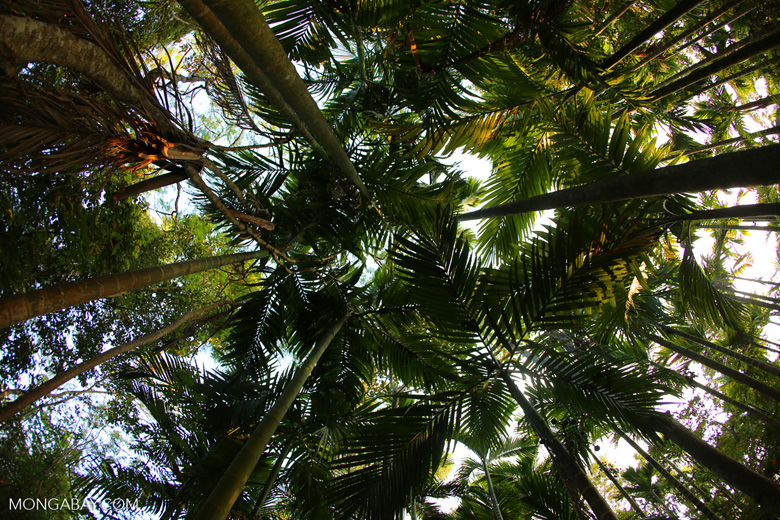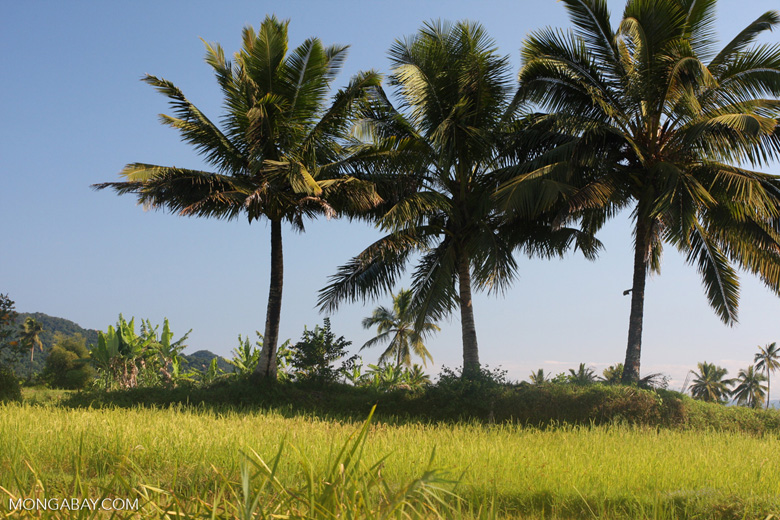The world faces a multitude of challenges, yet some of the toughest ones–from climate change to hunger, food security, water shortages, soil degradation, and loss of biodiversity–could be solved in part by agroforestry. Many agronomists, sustainable farming experts, and scientists argue that this traditional system of agriculture, which often combines tall woody perennials like trees and shrubs with annual crops, ought to be implemented more widely, since it produces food, fuel, fodder, and fiber while drawing carbon out of the atmosphere, while providing habitat for animals and plants, and building local water tables and soil profiles.
Shade grown coffee and chocolate are two of the best-known examples of agroforestry practices, but are perhaps the tip of the iceberg when it comes to the big picture. In addition to the ecological benefits, these systems can provide great benefits to people in terms of food security, livelihood enhancement, and community empowerment in addition to halting losses of agricultural, biological, and cultural diversity.
Though it may seem a very hip and new concept, an offshoot of the global permaculture movement perhaps, agroforestry has ancient roots and is still practiced widely in tropical regions and often by indigenous communities. While there’s been a recent surge in interest for soil carbon sequestration and even blue (marine) carbon projects, agroforestry has remained rather under the radar, especially versus widely discussed forest protection schemes like REDD+ and the Bonn Challenge. Despite this, an area of 250 million acres of agricultural land worldwide is estimated to be planted in such systems. Another estimate claims that 14% of European agricultural land is in some sort of agroforestry.

And now agroforestry is entering a new era of popularity as a solution, having just been named #28 in a list of “the 100 most substantive solutions to reverse global warming” by Project Drawdown, a comprehensive book project and plan authored by a group of leading scientists and thinkers from around the world and edited by ecological visionary Paul Hawken. Because agroforestry mimics forests, it can provide similar environmental benefits, the authors write, and its distribution has remained steady in recent decades.
Mongabay has written extensively about agroforestry in the past, and now aims to produce a series of stories over the next year focused on its implementation in many corners of the globe, by members of indigenous communities to conventional farmers and relatively new landowners looking for ways to grow a responsible business with multiple goals in mind.
Mongabay.com therefore seeks story pitches for this series that will foster a better understanding of the scale, scope, and impact of agroforestry systems from the local to global levels, with a special emphasis on indigenous peoples’ implementation of it and a geographical interest in (though not limited to) Melanesia (Vanuatu, the Solomon Islands, Fiji, and Papua New Guinea), the African Rift Valley (Kenya and Ethiopian Highlands), Central Asia (Kyrgyzstan and Tajikistan), northern Australia, and northwestern Mexico.
Topics and questions of interest include, but are not limited to:
- How do agroforestry systems support traditional, native communities in achieving or maintaining food security and access to medicines? What are the practical benefits to their foodways and livelihoods? (These questions will be returned to repeatedly)
- While agroforestry clearly benefits the global climate through increased carbon sequestration above and below ground, are there local and regional climate benefits too?
- Traditional “home garden” agroforests are known in the tropics to contain up to 70% of the biodiversity of surrounding native forests. What is the biodiversity benefit of agroforestry in the areas where it’s practiced?
- Because it relies on woody perennial crops as a major system component, how effectively does agroforestry root communities in place, provide a resilient and predictable livelihood, and stem the erosion of cultural, biological, and agricultural diversity?
- To what extent are countries and communities implementing agroforestry projects as part of their commitments under agreements like REDD+ and the Bonn Challenge? How well do these goals mesh in their objectives and outcomes?
- How important a role might carbon funds and green investors play in advancing the growth and adoption of agroforestry systems globally?
- What potential positive environmental effects can agroforestry polycultures of industrial crops that supply useful resins, fibers, and materials like rubber, provide?
- Are agroforestry techniques like alley cropping, silvopasturing, strip intercropping, and fodder banking growing in popularity?
- While these systems can empower communities and especially women who are the majority of the world’s farmers, while creating environmental benefits, what downsides are there to these techniques: lower yields, increased water use in arid climates, challenges with marketing the produce?
Examples of regionally specific topics of interest:
- What do the coffee/food/timber agroforestry systems of Papua New Guinea look like and are they helping communities resist businesses seeking to gain access to their lands for oil palm development?
- In the African Rift Valley, what does the perennial cultivation of enset in combination with cattle and crops look like?
- How well do the orchard-based agroforestry systems of Tajikistan function to protect soil and grow food via intercropping?
- Are recent efforts among Aboriginal communities to cultivate sandalwood and traditional ‘bush tucker’ crops in agroforestry systems in North Queensland, Australia working?
- What would cultivation of the edible saltmarsh grain ‘nipa’ (Distichlis palmeri) in coastal wetlands of northwestern Mexico look like, has there been much progress in its domestication, and who or what benefits? Is there a ‘blue carbon’ component to it?
- Are ‘jungle rubber’ agroforestry systems in Indonesia a viable alternative to the rubber monocultures that currently predominate?
- What effect is the intercropping of millions of hectares of trees with crops in temperate China having on biodiversity, water tables, and human livelihoods there?
- Tropical home gardens have existed for 13,000 years in Java, producing food, fuel, fodder, and medicines on small home-specific plots. What do these look like today, and are they still supporting families and communities in the ways that they always have?
- In the Sahel region of Africa, many farmers are abandoning modern plowed agriculture and are allowing forests to grow back from dormant roots and seeds, under which traditional crops are now grown. What does this look like in practice, and can it succeed in supporting farming communities’ food needs while increasing forest cover?

Mongabay will negotiate all fees and contracts on a per-story basis. Completed stories will be paid per word at a rate depending on the journalist’s experience and the complexity of the reporting. Reports will be published on Mongabay.com and sometimes at its Spanish language site, Mongabay-Latam, and elsewhere under an open Creative Commons license that allows for sharing and re-posting. Mongabay will also offer a small payment to journalists who proactively get their stories republished in major third-party print media outlets and on sites that draw more than 100,000 unique visitors per month.
Applications must be submitted in English, and the final reporting will be published first in English and then occasionally be translated into other languages, chiefly Spanish, by Mongabay.
Please submit your story ideas here along with your journalism resume. Pitches should be roughly 500 words in length. They should clearly explain the specific subject you would like to write about and your approach to covering it, describe a few potential sources, indicate if the topic involves any of the areas of special interest mentioned above or indigenous people, and say whether travel funding is necessary to complete the project (travel funds are available). Since this is an ongoing pitch solicitation, there is no deadline for submissions.